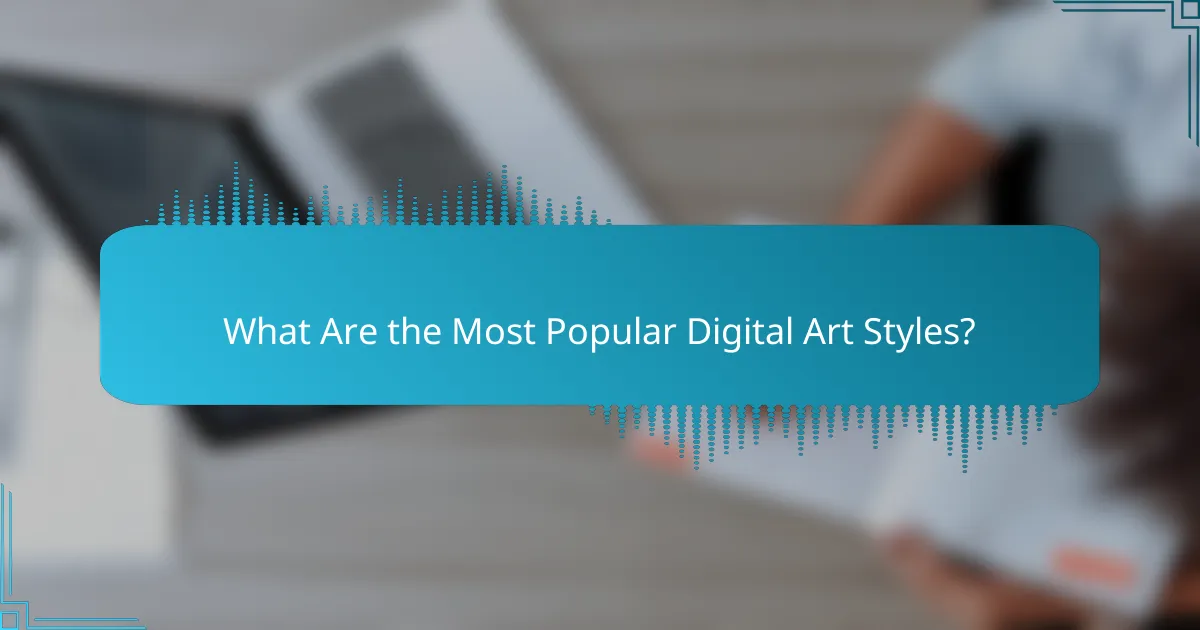Digital art has evolved into a vibrant field characterized by various styles such as illustration, 3D modeling, and pixel art, each offering unique techniques and appeals. Selecting the right technique is essential, as it depends on individual skills, project requirements, and software compatibility. With a plethora of tools available, artists can choose from software that best suits their creative needs and enhances their artistic expression.

What Are the Most Popular Digital Art Styles?
The most popular digital art styles include illustration, 3D modeling, concept art, pixel art, and digital painting. Each style has unique characteristics and techniques that appeal to different audiences and purposes.
Illustration
Illustration in digital art often combines traditional drawing techniques with digital tools to create images that convey ideas or tell stories. Artists typically use software like Adobe Illustrator or Procreate to produce detailed and vibrant visuals.
Common applications for digital illustrations include book covers, editorial pieces, and advertising. When creating illustrations, focus on composition and color theory to enhance visual impact.
3D Modeling
3D modeling involves creating three-dimensional representations of objects using specialized software such as Blender or Autodesk Maya. This style is widely used in video games, films, and virtual reality applications.
Key considerations in 3D modeling include polygon count, texture mapping, and lighting. Artists should aim for a balance between detail and performance, especially for real-time applications like gaming.
Concept Art
Concept art serves as a visual guide for projects, helping to establish the look and feel of characters, environments, and objects. Artists often create multiple iterations to explore different ideas and styles.
Tools like Photoshop and Sketchbook are popular for concept art. Focus on clarity and creativity, and remember that feedback from peers can significantly enhance the development process.
Pixel Art
Pixel art is a digital art form that uses small squares or “pixels” to create images, often reminiscent of retro video games. This style emphasizes simplicity and color palette limitations, making it accessible for beginners.
When creating pixel art, consider using software like Aseprite or Piskel. Pay attention to grid alignment and color choices to maintain visual coherence and appeal.
Digital Painting
Digital painting mimics traditional painting techniques using digital tools, allowing artists to create rich, textured artworks. Software such as Corel Painter and Krita offers a variety of brushes and effects to simulate real-world media.
For effective digital painting, practice layering and blending techniques. Experiment with different brushes and textures to find a unique style that resonates with your artistic vision.

How to Choose the Right Digital Art Technique?
Choosing the right digital art technique involves assessing your skills, understanding your project requirements, and ensuring software compatibility. Each technique has its strengths and weaknesses, so aligning them with your goals is crucial for success.
Assessing Your Skill Level
Your skill level plays a significant role in selecting a digital art technique. Beginners may benefit from simpler methods like vector art or basic painting, while more experienced artists might explore complex techniques such as 3D modeling or digital sculpting.
Consider taking an inventory of your current abilities. If you are comfortable with traditional art, transitioning to digital painting could be a smooth process. However, if you are new to art altogether, starting with user-friendly software can help build confidence.
Understanding Project Requirements
Before choosing a technique, clearly define the goals of your project. Are you creating illustrations for a book, designing characters for a game, or producing concept art? Each type of project may require different techniques and styles.
For instance, if you need high detail and realism, techniques like digital painting or photobashing may be more suitable. Conversely, for quick sketches or prototypes, simpler methods like line art or pixel art could suffice.
Exploring Software Compatibility
Software compatibility is essential when selecting a digital art technique. Different techniques often require specific software tools, so ensure that your chosen method aligns with the programs you have access to.
Popular software options include Adobe Photoshop for painting, Blender for 3D modeling, and Procreate for illustration on tablets. Check if your hardware meets the software requirements, and consider trial versions to test compatibility before committing.

What Are the Best Tools for Digital Art Creation?
The best tools for digital art creation include software that offers a range of features tailored for artists, such as drawing, painting, and editing capabilities. Popular choices vary based on user preference, skill level, and specific artistic needs.
Adobe Photoshop
Adobe Photoshop is a leading software in the digital art community, known for its versatility and powerful editing tools. It supports raster graphics and offers features like layers, brushes, and advanced color management, making it suitable for both illustrations and photo editing.
When using Photoshop, consider its subscription model, which can be a significant investment over time. However, its extensive tutorials and community support can help new users quickly become proficient.
Procreate
Procreate is a popular choice among digital artists, especially those using iPads. It provides a user-friendly interface and a wide variety of brushes and tools, allowing for intuitive drawing and painting experiences.
This app is a one-time purchase, making it more affordable than subscription-based software. Procreate’s portability on iPads also allows artists to create on the go, which is a significant advantage for many users.
Corel Painter
Corel Painter is designed specifically for digital painting, offering a vast array of brushes that mimic traditional media. This software is ideal for artists looking to replicate the look and feel of oil, watercolor, or pastels in a digital format.
While Corel Painter can be more complex than other options, its depth of features allows for a high level of customization. Users should be prepared for a learning curve, but the results can be stunning for those willing to invest the time.
Clip Studio Paint
Clip Studio Paint is favored by comic and manga artists due to its specialized tools for creating panels, speech bubbles, and character designs. It combines raster and vector capabilities, allowing for detailed artwork and easy adjustments.
This software offers a one-time purchase option or a subscription, appealing to different user preferences. Its robust community and extensive resources make it easier for beginners to learn the software and improve their skills.

How to Sell Digital Art Online?
Selling digital art online involves showcasing your work on various platforms and connecting with potential buyers. Consider using online marketplaces, building a personal website, and leveraging social media to maximize your reach and sales potential.
Using Online Marketplaces
Online marketplaces like Etsy, Redbubble, and ArtStation provide artists with a ready-made audience. These platforms allow you to upload your digital art, set prices, and manage sales with minimal setup.
When using these marketplaces, be mindful of their fees, which can range from a small percentage of sales to listing fees. Ensure your artwork is optimized with relevant tags and descriptions to improve visibility.
Building a Personal Website
A personal website serves as a dedicated space for your portfolio and brand. It allows you to showcase your digital art in a professional manner and gives you full control over pricing and sales.
Consider using platforms like WordPress or Squarespace to create your site. Include an online store feature, and ensure your website is mobile-friendly. Regularly update your content to keep visitors engaged and encourage repeat visits.
Leveraging Social Media
Social media platforms such as Instagram, Facebook, and Pinterest are powerful tools for promoting your digital art. They enable you to share your work, connect with followers, and drive traffic to your online store.
Engage with your audience by posting regularly, using relevant hashtags, and participating in art challenges. Collaborating with other artists or influencers can also expand your reach and attract new customers.

What Are the Latest Innovations in Digital Art?
The latest innovations in digital art include advancements in technology that enhance creativity and interactivity. These innovations are transforming how artists create and audiences engage with art, making it more immersive and accessible.
AI-Generated Art
AI-generated art utilizes algorithms and machine learning to create unique pieces based on input data. Artists can use platforms like DALL-E or Artbreeder to generate images, often blending styles or themes in ways that would be challenging manually.
When working with AI tools, it’s essential to understand the balance between human creativity and machine output. While AI can produce stunning visuals quickly, the artist’s vision and direction remain crucial for meaningful results.
Augmented Reality Integration
Augmented reality (AR) integration allows digital art to interact with the physical world, enhancing viewer experiences. Artists can create installations that viewers can engage with through smartphones or AR glasses, adding layers of information or animation to static pieces.
To effectively use AR in digital art, consider the user experience. Ensure that the technology is accessible and intuitive, and think about how the AR elements complement the physical artwork rather than distract from it.
Interactive Digital Installations
Interactive digital installations invite audience participation, making the viewer an integral part of the artwork. These installations can range from simple touch-responsive displays to complex environments that change based on audience movement or input.
When designing interactive installations, focus on creating an engaging experience that encourages exploration. Use sensors and software that respond fluidly to user interactions, and consider the space where the installation will be displayed to maximize impact.


